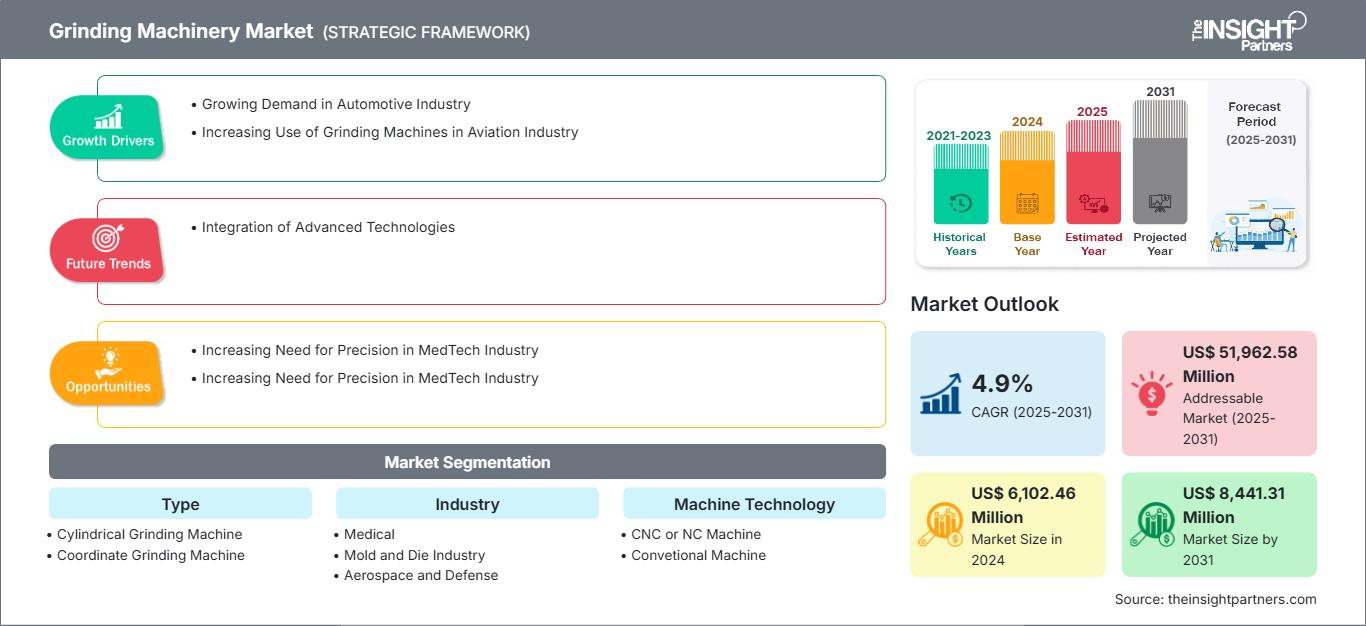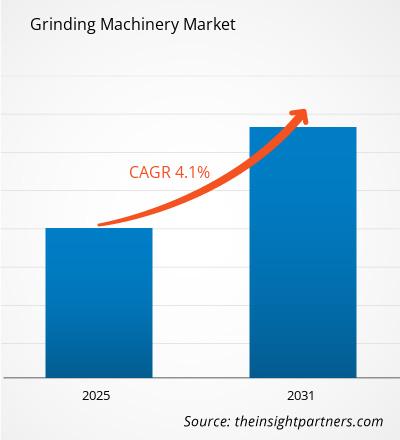预计到 2031 年,磨削机械市场规模将从 2024 年的 61.0246 亿美元增至 84.4131 亿美元。预计该市场在 2025 年至 2031 年期间的复合年增长率为 4.9%。先进技术的日益普及可能会在未来几年为市场带来新的趋势。
磨削机械市场分析
磨削机械在制造业中发挥着基础性作用,有助于生产用于汽车、航空航天、电子和医疗等各个行业的高精度部件。随着行业的发展和对精密部件需求的增加,预计磨削机械市场在预测期内将经历显著增长。磨削机械是指利用磨料工具从工件上去除材料,以获得所需尺寸、形状和表面光洁度的机器。这些机器对于各种工艺都至关重要,包括表面磨削、外圆磨削、内圆磨削和工具磨削。市场涵盖各种类型的磨床,包括平面磨床、外圆磨床、工具和刀具磨床、无心磨床以及专用磨床。
磨床市场概览
计算机数控 (CNC) 技术与自动化在磨床中的集成彻底改变了制造流程。这些进步提高了精度、能力和生产力,使制造商能够满足严格的质量标准。汽车、医疗设备和航空航天等行业需要公差小、表面光洁度高的零部件。对质量和精度的日益重视推动了对先进磨床的需求。此外,新兴经济体(尤其是亚太和南美洲)的快速工业化也促进了磨床市场的增长。
自定义此报告以满足您的要求
您将免费获得任何报告的定制,包括本报告的部分内容,或国家级分析、Excel 数据包,以及为初创企业和大学提供超值优惠和折扣
磨削机械市场: 战略洞察

- 获取本报告的主要市场趋势。这个免费样本将包括数据分析,从市场趋势到估计和预测。
您将免费获得任何报告的定制,包括本报告的部分内容,或国家级分析、Excel 数据包,以及为初创企业和大学提供超值优惠和折扣
磨削机械市场: 战略洞察

- 获取本报告的主要市场趋势。这个免费样本将包括数据分析,从市场趋势到估计和预测。
磨削机械市场驱动力与机遇
汽车行业需求不断增长
汽车行业的制造商不断寻求提高生产效率、降低成本和改善产品质量的方法。为了实现这一目标,他们在工厂中部署了数控机床等磨床,这些机床具有高精度、灵活性和自动化功能。汽车行业在零部件装配、制造和表面处理等环节高度依赖传统和先进的磨床。在汽车行业,磨床主要用于制造发动机部件、底盘部件和车身面板。磨床应用于汽车生产的各个阶段,从单个部件的制造到整车的组装。磨削对于生产凸轮轴、曲轴和气缸盖等发动机部件至关重要。这些部件需要高精度和表面光洁度,以确保最佳性能和使用寿命。例如,曲轴通常需要磨削才能达到对发动机效率至关重要的严格公差。齿轮和轴等部件也需要磨削来增强其表面性能和尺寸精度。磨削过程还有助于减少磨损和摩擦,这对于平稳的传动运行至关重要。
医疗科技行业对精密度的需求日益增长
医疗科技行业对精密度的需求日益增长,预计将为磨削机械市场带来巨大的增长机会,因为该行业需要用于医疗工具和设备的高精度定制组件。医疗技术行业越来越注重开发微创手术器械、复杂植入物和诊断设备,所有这些都需要高精度和定制化的组件。磨削机械能够生产公差严格且微小复杂的零件,对于满足医疗器械制造工艺的精度要求至关重要。个性化医疗(例如定制植入物和假肢)的需求日益增长,推动了对精密磨削机械的需求,以制造这些组件。磨削机械在生产手术器械所需的精密部件方面发挥着至关重要的作用,确保了手术器械的安全性和性能。世界卫生组织 (WHO) 预测,到 2050 年,60 岁及以上人口数量将达到约 21 亿。这种人口结构的变化增加了对用于治疗慢性疾病和与年龄相关的健康问题的医疗设备和技术的需求。美敦力等公司专注于开发先进的心血管设备和糖尿病管理解决方案,并意识到老年人对慢性疾病管理的迫切需求。
磨削机械市场报告细分分析
促成磨削机械市场分析的关键细分领域包括类型、行业和机械技术。
- 按类型,市场分为外圆磨床、坐标磨床和其他类型。 2024 年,其他细分市场占据了市场主导地位。
- 按行业划分,市场分为医疗、模具工业、航空航天和国防、汽车、电气和电子、工业机械等。2024 年,汽车细分市场占据了市场主导地位。
- 根据机械技术,市场分为 CNC/NC 机器和传统机器。2024 年,CNC/NC 机器细分市场占据了市场主导地位。
按地域划分的磨削机械市场份额分析
磨削机械市场分为五大区域:北美、欧洲、亚太地区 (APAC)、中东和非洲 (MEA) 以及南美和中美 (SAM)。2024 年,北美占据了市场主导地位,其次是欧洲和亚太地区。
凭借强大的工业基础和技术进步,亚太地区在磨削机械市场中占据突出地位。中国在该地区占据主导地位。日本、韩国和印度是亚太市场的主要贡献者。中国是该地区重要的制造业中心之一。航空航天、汽车、国防和工业机械制造等行业的存在推动了亚太地区对磨削机械的需求。这些行业需要先进的制造解决方案来满足日益增长的精密部件需求。中国和印度的国防和航空航天业在推动磨削机械市场方面发挥着重要作用。持续的技术创新和军费开支的增加促进了市场的增长。2022年,中国制造业的显著扩张,制造业采购经理人指数(PMI)的高位表明磨削机械的生产和需求增加。随着PMI达到十多年来的最高水平并显示出明显的扩张趋势,这标志着依赖磨削机械的行业拥有良好的发展环境。因此,工业领域的不断发展和制造业精密制造的兴起正在推动亚太地区磨削机械的增长。工业化进程的加快和汽车制造中心数量的增加,正在推动北美磨削机械市场的增长。北美制造业的复苏,尤其是美国和加拿大制造业的复苏,是磨削机械市场的重要驱动力。制造业回流和国内生产能力投资的增加,导致对能够生产高质量零部件的磨床的需求增加。欧洲在全球磨削机械市场中占有相当大的份额。该地区以其成熟的制造业而闻名,包括汽车、航空航天、工业机械和医疗设备。这些行业严重依赖磨削机械来实现高精度和高效率的制造工艺。德国是欧洲的一个重要市场,以其创新的工程和制造能力而闻名。德国高度重视创新、自动化和数字化,推动了对磨削机械的需求。2022年,德国政府投资2200亿美元用于工业转型;德国正致力于航空航天和工业制造业的发展,这将导致对尖端磨削机械的需求增加。此外,欧洲市场的特点是采用数控机床和精密制造。可持续性、能源效率和环境法规的突出地位进一步影响着市场动态。
磨削机械市场磨削机械市场
磨削机械市场
The Insight Partners 的分析师已详尽阐述了预测期内影响磨削机械市场的区域趋势和因素。本节还讨论了北美、欧洲、亚太地区、中东和非洲以及南美和中美洲的磨削机械市场细分和地域分布。
磨削机械市场报告范围
| 报告属性 | 细节 |
|---|---|
| 市场规模 2024 | US$ 6,102.46 Million |
| 市场规模 2031 | US$ 8,441.31 Million |
| 全球复合年增长率 (2025 - 2031) | 4.9% |
| 历史数据 | 2021-2023 |
| 预测期 | 2025-2031 |
| 涵盖的领域 |
By 类型
|
| 覆盖地区和国家 | 北美
|
| 市场领导者和主要公司简介 |
|
磨削机械市场参与者密度:了解其对业务动态的影响
磨削机械市场正在快速增长,这得益于终端用户需求的不断增长,而这些需求的驱动因素包括消费者偏好的不断变化、技术进步以及对产品优势的认知度不断提高。随着需求的增长,企业正在扩展产品线,不断创新以满足消费者需求,并抓住新兴趋势,从而进一步推动市场增长。

- 获取 磨削机械市场 主要参与者概述
磨削机械市场新闻及最新动态
磨削机械市场评估通过收集一手和二手研究后的定性和定量数据进行,这些数据包括重要的公司出版物、协会数据和数据库。磨削机械市场的一些关键发展如下:
- 联合磨削集团 (UNITED GRINDING Group) 加强了其东南亚业务,并在新加坡成立了自己的子公司。多年来,联合磨削集团一直通过其代表处和 WALTEREWAG 亚太子公司在东南亚地区开展业务。如今,这家磨削、电蚀、激光和测量机器专家通过在新加坡成立集团子公司 United Grinding Asia Pacific Pte. Ltd.,整合并加强了其在该地区的业务。(来源:联合磨削集团,新闻稿,2023 年 11 月)
- PALMARY Machinery Co., Ltd. 宣布推出 VIG-120 产品。 VIG-120系列立式磨床是一款卓越的设备。它采用蜂窝管状机身、十字导轨床身设计,X轴和Y轴均采用交叉滚子直线导轨,具有卓越的承重能力。此外,该磨床还配备了高刚性工作主轴和ATC(自动换刀)系统。 (来源:PALMARY Machinery Co., Ltd,新闻稿,2023 年 3 月)
磨削机械市场报告覆盖范围和可交付成果
《磨削机械市场规模和预测(2021-2031)》对市场进行了详细的分析,涵盖以下领域:
- 磨削机械市场规模和预测,涵盖范围内所有主要细分市场的全球、区域和国家/地区
- 磨削机械市场趋势以及市场动态,例如驱动因素、限制因素和关键机遇
- 详细的 PEST 和 SWOT 分析
- 磨削机械市场分析,涵盖主要市场趋势、全球和区域框架、主要参与者、法规和最新市场发展
- 行业格局和竞争分析,涵盖市场集中度、热图分析、知名参与者和磨削机械市场的最新发展
- 详细的公司简介
- 历史分析(2 年)、基准年、预测(7 年)及复合年增长率
- PEST和SWOT分析
- 市场规模、价值/数量 - 全球、区域、国家
- 行业和竞争格局
- Excel 数据集
近期报告
客户评价
购买理由
- 明智的决策
- 了解市场动态
- 竞争分析
- 客户洞察
- 市场预测
- 风险规避
- 战略规划
- 投资论证
- 识别新兴市场
- 优化营销策略
- 提升运营效率
- 顺应监管趋势




















 获取免费样品 - 磨削机械市场
获取免费样品 - 磨削机械市场